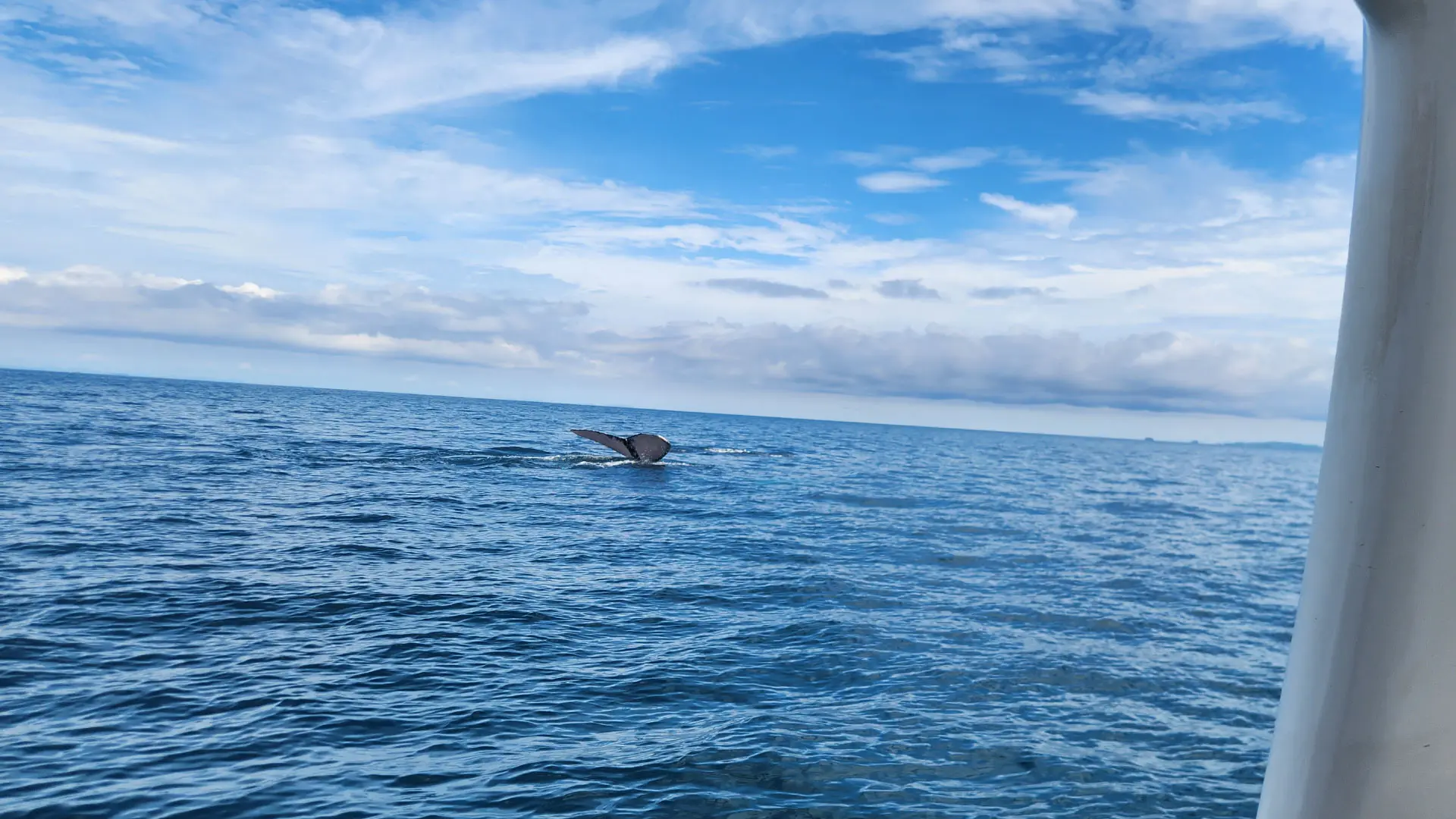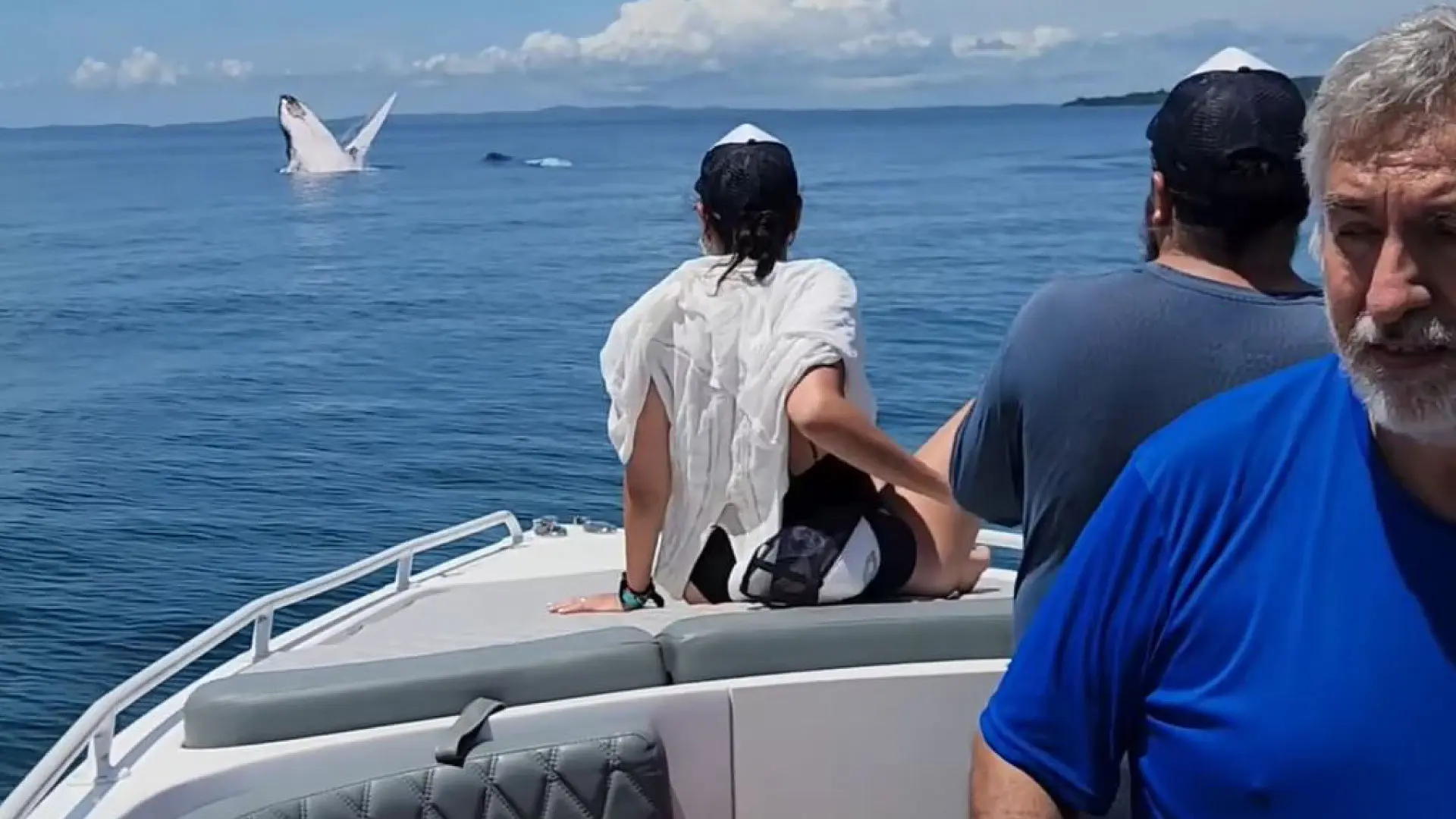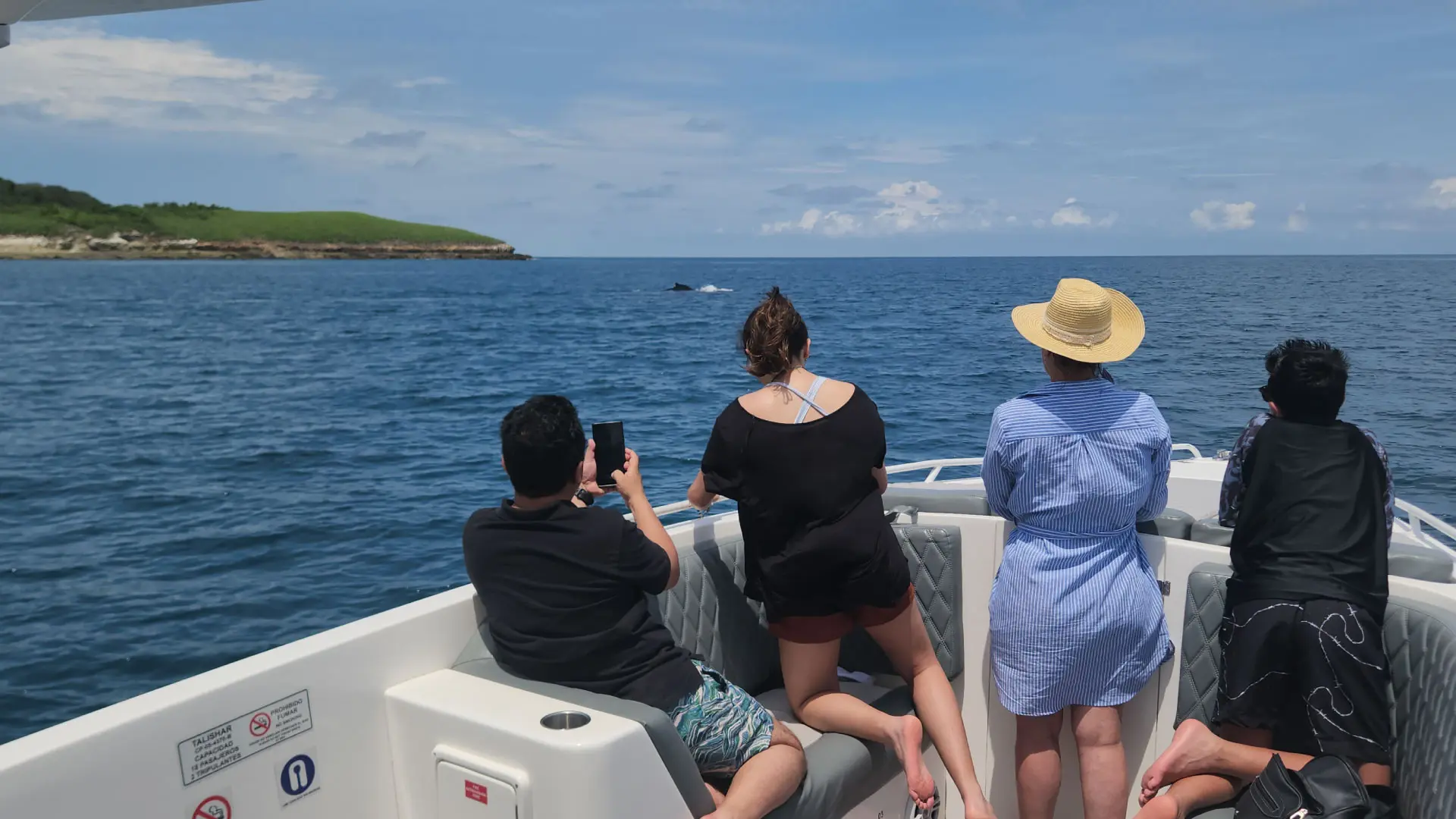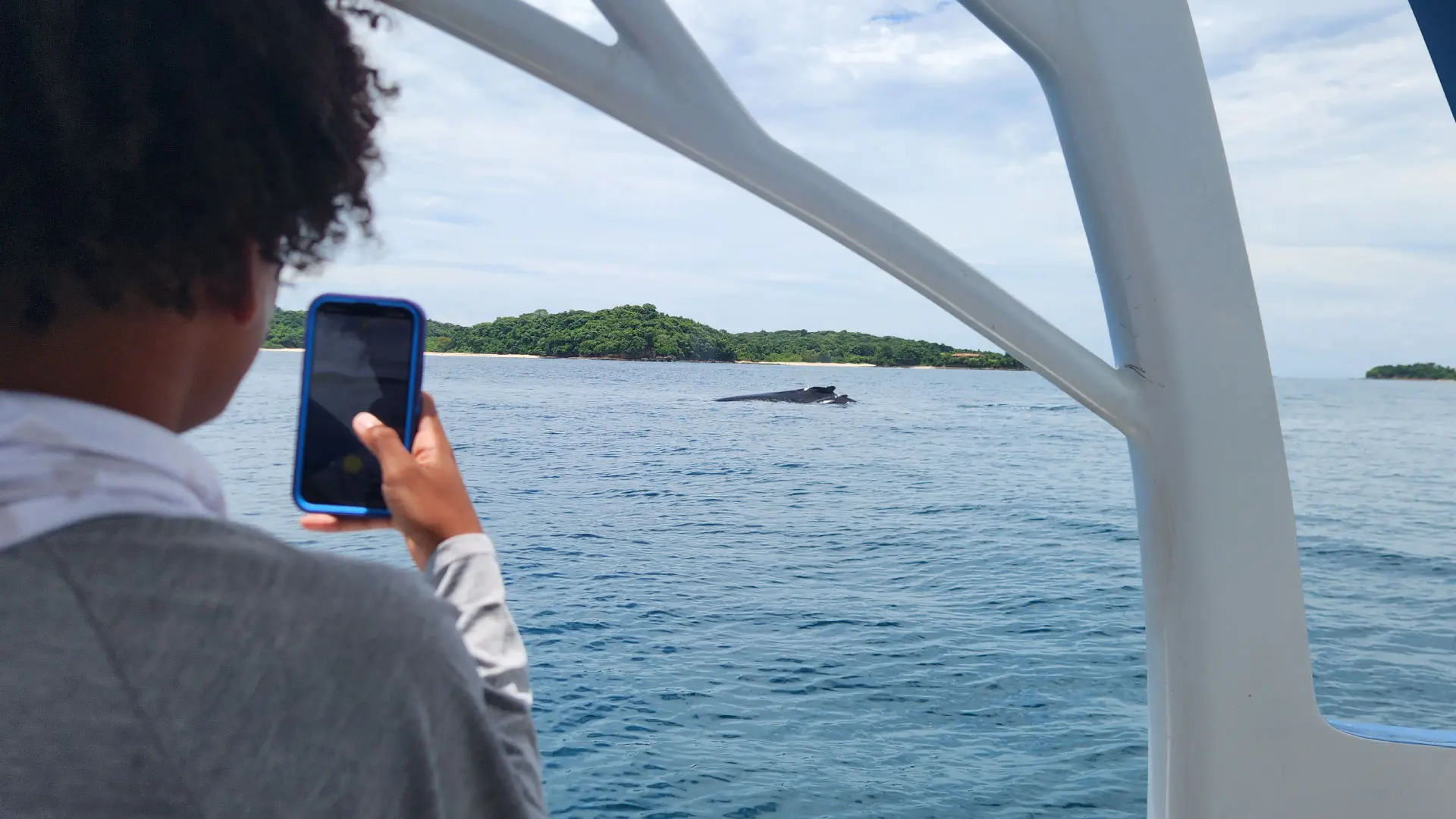If you are a free soul who loves the ocean and hasn’t gone Whale Watching yet, you might have questions about the experience. We want to answer them for you.
Is Whale Watching Safe?
Whale watching can be a safe and enjoyable activity when conducted responsibly and with respect for the animals and their environment. To make sure it is a safe and fun experience, you should consider a few things when booking your tour:
- Choose an operator with a good reputation. They will probably prioritize safety, follow the regulations, and hire experienced guides knowledgeable about the laws, whales’ behaviors, and marine landscape.
- Follow guidelines and regulations: Panama has specific guidelines and regulations to ensure the safety of humans and marine life. Make sure you follow the crew’s guidance.
- It’s vital to maintain a safe distance from the whales. Approaching too closely can disturb their natural behavior and potentially put humans and whales at risk. Different regions and countries have specific distance requirements; for Whale Watching in Panama, the vessel should be at least 250 meters from the cetaceans unless the whales approach the boat alone.
- Remember that you are a guest in their environment and should show respect. Don’t do anything to stress or harm the whales, such as feeding them, throwing objects into the water, or making sudden movements.
- The boat should have proper safety gear, such as life jackets and communication equipment; ask your tour operator before departure.
- If you have any health conditions that could be aggravated by sea travel, it’s wise to consult a medical professional before participating in a whale-watching tour.
- If you’re considering bringing children or individuals with special needs, ensure the tour operator can accommodate their specific requirements.

Are whale-watching tours dangerous?
Whale-watching tours are not considered dangerous. Reputable whale-watching operators prioritize the safety of their passengers, crew, and marine animals. However, like any outdoor activity, there are potential risks and factors to consider:
- The safety of the boat is a significant factor. Ensure the boat is well-maintained, equipped with necessary safety gear, and operated by trained and experienced crew members. If you don’t know what makes a boat safe, here are some tips to check out before you book your tour.
- Sea conditions can vary, and rough waters could make the boat tour uncomfortable for passengers. Although responsible captains closely monitor weather and sea conditions, unexpected changes could always affect the tour.
- While very rare, accidents can happen at sea. To prevent slips, trips, and other accidents on the boat, it’s essential to follow crew instructions and be mindful of your surroundings. Also, ensure the tour operator has passenger insurance coverage before coming aboard.
- Some passengers may experience motion sickness, especially if they’re not used to being on a boat. If you’re prone to motion sickness, bringing the necessary precautions or medications with you is a good idea.
Can I go in the water and swim with the whales?
This is not recommended as whales are still wild animals, making them unpredictable. Whales’ size and strength pose a threat to humans if they were to hit you, even by accident. Also, remember that most whales are mothers with their calves, who will act if they perceive a threat to their babies.
Nonetheless, If you take a whale-watching tour with Gem Charters, you will also go island hopping and visit several warm water beaches.
What kind of whales are there in Panama?
- Humpback whales are our main attraction since they have to surface every 40 minutes to breathe. They don’t live full-time in Panama (or anywhere, for that matter); they come to the warmer waters of Panama to escape the cold winters of the poles.
- The short-finned pilot whale resides in Panama (mainly around the Gulf of Chiriquí and Coiba Island). However, since they prefer to live in deeper, offshore areas, they are harder to spot.
- Bryde’s Whales are also permanent residents of Panama. Their breathing system allows them to blow or exhale underwater, making them harder to see.
- Blue Whales. Yes, the largest known animal is a visitor to Panama’s Pacific coast. They are hard to spot because, due to whaling, there aren’t many left.
- Other species: You can see other whales like the Sei Whale and Sperm Whale since they are common visitors to the Pacific Ocean. Other smaller species include the pygmy beaked whale, Blainville’s beaked whale, pygmy sperm whale, dwarf sperm whale, Curvier’s beaked whale, minke whale, and melon-headed whale.
Can you go whale watching in the rain?
Yes, you can go whale watching in the rain, but whether or not the tour will proceed depends on various factors, including the severity of the rain, sea conditions, and the policies of the whale-watching operator:
- Whale-watching operators may continue their tours in light rain or drizzle if sea conditions are safe. Others might cancel or reschedule tours if the rain is heavy or the weather makes the sea conditions rough.
- Heavy Rain could affect visibility, making it challenging to spot whales and enjoy the experience. However, some species of whales are more active during rainy weather, so you might have a unique opportunity to observe certain behaviors.
- Rainy weather can make the boat ride less comfortable for passengers. However, rain in Panama is fairly warm, so you will not suffer from hypothermia or other risk factors that you might face in colder climates. Also, remember that rain might not last too long as you are in the tropics.

Do whale-watching boat tours have bathrooms?
All of our vessels have bathrooms, but the number and flexibility of the facilities will vary depending on the boat you are booking.
When is whale watching season?
While this varies in different regions, in Panama, whale watching season is from mid-June to November. The dates might change depending on the year; ask your tour operator for certainty on the whale-watching experience.
Where can I go whale watching?
There are several spots in Panama where whales can be seen. However, we recommend the Pearl Islands. One of the main reasons we recommend this is that the tours depart from Flamenco Marina in Panama City. This avoids having to drive to other provinces to take a boat offshore. Also, Pearl Islands has more than 200 islands with incredibly beautiful beaches you can enjoy. If you want to know more about this tour, you can check out our Whale Watching Tour.
What is the best time to go whale watching?
Since our whale-watching tour at Pear Islands is a full-day experience, we recommend going early so you can enjoy the sunlight, island hopping, snorkeling, and more.
Is whale watching worth it?
Whether whale watching is worth it depends on your expectations for the trip. Many companies just take you out to see the whales for a while and then return to land, but with Gem Charters, you will also get a fishing, island hopping, and Crystal Clear beaches experience. We promise the tour with Gem Charters is worth it.
Other things you should consider (and value) before booking:
- Whale watching can be an incredible and awe-inspiring experience. Observing these magnificent creatures in their natural habitat can create lasting memories.
- Whale-watching tours offer educational value because our tours include knowledgeable crew who provide information about whale behavior and conservation.
- The tour is also a unique opportunity to connect with the natural world and appreciate the beauty and diversity of marine environments. Being out on the water and surrounded by nature can be a refreshing and meditative experience.
- Spotting a whale in the wild can be thrilling and rewarding, but you might also see other marine animals, such as dolphins, turtles, sharks, sea rays, and more.
- By participating in a reputable tour, you’re supporting efforts to raise awareness about the importance of protecting these animals and conserving their habitats.

Is whale watching ethical?
It can be ethical when conducted responsibly and following guidelines, prioritizing the well-being of the whales and the environment.
Ethical whale watching aims to minimize disturbance to the animals and their habitats while providing educational and sustainable experiences for participants.
- Ethical whale watching prioritizes the respect and well-being of the animals.
- Responsible operators follow strict guidelines to minimize their impact on the marine environment. This includes adhering to regulations about engine noise, waste disposal, and avoiding sensitive habitats.
- Local Involvement: Ethical operators work closely with local communities and authorities to ensure their activities align with the community’s interests and comply with local regulations.
- It can help marine biologists and researchers contribute to scientific knowledge about whale behavior, migration patterns, and population dynamics.
- Tours with smaller groups (such as our private tours) have less impact and a more intimate experience, reducing the potential for overwhelming the animals.
Look for reputable companies with a proven track record of responsible practices, positive customer reviews, and adherence to local regulations. By supporting ethical whale watching, you can contribute to protecting marine life while enjoying an enriching and memorable experience.

What are the rules for whale watching?
We mentioned some already, but just to make it clear, this is what your whale-watching tour rules should be:
- Keep a safe distance from the whales to avoid causing stress or disrupting their natural behaviors.
- Do not engage in behavior that could harass, chase, or disturb the whales. Avoid sudden movements, loud noises, and actions that could startle the animals.
- Do not attempt to feed the whales or throw any objects into the water. Feeding can disrupt their natural foraging behaviors and harm their health.
- Do not swim or dive near whales, which can be dangerous for humans and animals. Whales are large and powerful creatures, and close encounters can lead to accidental collisions; it is also illegal in Panama.
- Spending extended periods with whales can cause stress. Responsible operators limit the viewing time to ensure the animals are not exposed to prolonged human presence.
- Approach whales slowly and cautiously, without sudden changes in speed or direction. This minimizes the chance of startling the animals.
- Keep engine noise to a minimum to avoid disturbing the whales. Quiet engines are less likely to disrupt their behaviors and communication.
- Do not crowd multiple boats around a single group of whales. This can stress the animals and lead to unsafe situations.
- Be particularly cautious and respectful when encountering a mother whale with a calf. Mothers with calves are especially vulnerable and protective.
- Different regions and countries may have specific regulations and guidelines for whale watching. This guide was created mainly based on Panamanian laws and experience. Always adhere to the local rules and recommendations.
- Listen to and follow the instructions of the crew members or guides on the whale-watching tour. They are trained to ensure your safety and the well-being of the animals.
Participating in Whale Watching depends on your interests, willingness to embrace nature’s unpredictability, and appreciation for marine life and conservation efforts. If you have the opportunity to engage with a reputable operator and have realistic expectations, it can provide an enriching and memorable experience that fosters a deeper connection to the natural world.
You might also like to read:
8 GREAT REASONS TO TRY FISHING
Follow us on social media:


